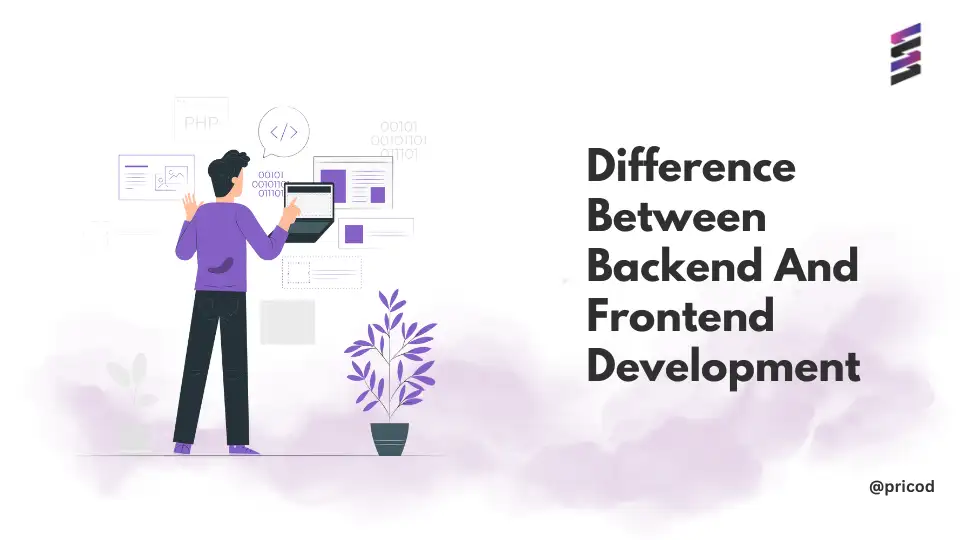
Difference Between Backend and Frontend Development
The phrases “front end” and “back end” are used interchangeably in the software development industry. These terms have entered the vernacular and now characterize the work, responsibilities, and compensation of software developers. But you may ask, “What do they mean?”
Also, what is the rationale for these differences? To better grasp these two critical responsibilities in building websites and applications, let’s dive into the distinctions between frontend and backend development.
Frontend Development
An essential part of web development, front-end development deals with the graphical aspects of a site or app. This is sometimes called client-side development. Features that are instantly apparent and used by the client or end-user are the responsibility of a front-end developer. Enhancing the user experience encompasses all aspects of design, including visual elements, content, alignment, navigation, color scheme, and style.
Roles and Responsibilities of a Frontend Developer
The work of a front-end developer encompasses many different aspects that go into making an app or website seem good as a whole. Among their primary duties is the creation of intuitive user interfaces through the application of frontend frameworks, HTML, CSS, and JavaScript.
- Testing the site or app on various devices and browsers to make sure it works well.
- Creating a practical user interface by working together with designers.
- Making sure the user experience is seamless by regularly testing and debugging.
- Making code more efficient and reducing loading times.
Features of Frontend Development
Because of its many useful features, front-end development is a crucial part of building websites. Among these characteristics are:
- Rendering on the client side: This technique lets programmers utilize JavaScript to create the full website on the user’s browser, which improves performance and user experience.
- Compatibility across platforms: Frontend development guarantees that apps and webpages function flawlessly on various devices, browsers, and OSes.
- One of the main goals of front-end development is to make user interfaces that are pleasing to the eye, simple to navigate, and straightforward to use.
- To transmit data from the server to the user’s browser, front-end development incorporates backend technology without a hitch.
Backend Development
Backend development, also known as server-side development, is responsible for all the processes that happen behind the scenes of a website or application. A backend developer is responsible for ensuring the functionality, security, and performance of a website or application.
Roles and Responsibilities of a Backend Developer
A backend developer has several responsibilities that contribute to the overall functionality of a website or application. Some of these responsibilities include:
- Designing and developing databases using DBMS technologies like SQL, MySQL, MongoDB, etc.
- Writing server-side code using programming languages like Java, Python, Ruby, etc.
- Implementing APIs to communicate data between the client and server.
- Ensuring data security by implementing proper authentication and authorization protocols.
- Regularly testing and debugging code for optimum performance.
Features of Backend Development
Web development would not be complete without backend development and its many useful features. Among these characteristics are:
- Faster page loads and improved search engine optimization are the outcomes of server-side rendering, an alternative to front-end development that places the rendering burden on the server.
- Backend developers make use of database management system (DBMS) technology for effective data storage and administration.
- Security measures: To prevent unauthorized access to sensitive data, the backend must employ strong security protocols.
Frontend vs Backend
Frontend and backend creation go hand in hand to make a website or app that works properly. Backend developers handle the server-side tasks and data handling, while frontend developers work on the look and feel of the site and how users interact with it.
Frontend and backend writers must work together to make a product that works well and smoothly. APIs let the client and server send and receive data, which makes sure that the front end always has the most up-to-date information. Backend technologies are also used by frontend writers to handle user authentication and data security.
Conclusion
In conclusion, both frontend and backend development play crucial roles in creating a successful website or application. While the front end focuses on the visual aspects and user experience, the back end ensures functionality, security, and performance. Collaboration between the two is necessary for creating a seamless and efficient product that meets both client and user expectations.
At Pricod, our team of experienced front-end and back-end developers work together to create stunning websites and applications. With our expertise in both areas, we ensure that your product not only looks visually appealing but also functions seamlessly with efficient data management and security measures in place.Trust us to bring your vision to life with our collaborative approach and cutting-edge technologies. Contact us today for all your front-end and back-end development needs. So, why settle for just one aspect of web development when you can have the best of both worlds with Pricod? Choose us as your partner in creating a successful digital presence.
